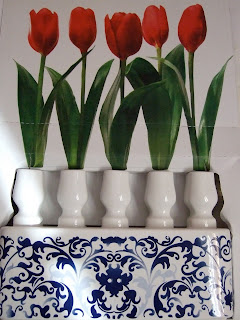I would like to have a room, an empty room.
In May, I would open the window for sunbeams to explode on a precious vase full of tulips. Sit on the floor, cross-legged, I would be absorbed in a dispute between the beauty of the vase and that of the flowers.
“Fifty years after the end of tulipomania, the first of the so-called tulip vases began to appear, strange tall pagoda-like creations with spouts jutting out at the top and sides. For a long time it was assumed that the vases were used either for displaying tulip flowers or for growing tulips indoors, the bulbs placed over water in spouts, much as hyacinths are grown today.“ (Pavord 1999; 180)
The extravagant craze called tulipomania happened in The Netherlands around 1630 and overwhelmed fortunes and men. Tulips came from East. Wild species bloomed in the steep mountains and the wide valleys of Central Asia, thriving on harsh winters and torrid summers. Single and simple flowers showed basic colours, sometimes with a black blotch at the base or stripes along the petals, but with such a variety of combinations that, today, the species classified are more than 120. For nomadic tribes who lived in that desolated land they were the sign of incoming spring and new life. Around 1050, tulips were cultivated in refined Persian gardens. Their name, composed with the same letters of the name of Allah, lâleh, echoed in legends of eternal love and passion. Later, they were the beloved flowers of the Sultans when Ottoman Istanbul was a town of gardens and green spaces. Tulips embellished the secret court in the Palace of Joy or Topkapi Saray and sumptuous night parties celebrated their blooming. Probably around the second half of the sixteenth century, they reached without clamour Europe, their name recalling the oriental shape of the turban. Little by little, they gained interest and fame as decorating plants, after having been studied for medical purposes and experimented in bold recipes. The inexplicable mutations of their colours thrilled botanists and amateurs, while for rich merchants and wealthy artisans they emerged as the symbol of fortune and success. Speculations rose to absurd levels transforming the flower in a luxury commodity, such as exotic birds and ornate fountains.
 “But their use remain a puzzle. None of the hundreds of flower paintings of the Golden Age shows flowers in a Delftware holder.” (Pavord 1999; 180)
“But their use remain a puzzle. None of the hundreds of flower paintings of the Golden Age shows flowers in a Delftware holder.” (Pavord 1999; 180)
The extravagant craze called tulipomania happened in The Netherlands around 1630 and overwhelmed fortunes and men. Tulips came from East. Wild species bloomed in the steep mountains and the wide valleys of Central Asia, thriving on harsh winters and torrid summers. Single and simple flowers showed basic colours, sometimes with a black blotch at the base or stripes along the petals, but with such a variety of combinations that, today, the species classified are more than 120. For nomadic tribes who lived in that desolated land they were the sign of incoming spring and new life. Around 1050, tulips were cultivated in refined Persian gardens. Their name, composed with the same letters of the name of Allah, lâleh, echoed in legends of eternal love and passion. Later, they were the beloved flowers of the Sultans when Ottoman Istanbul was a town of gardens and green spaces. Tulips embellished the secret court in the Palace of Joy or Topkapi Saray and sumptuous night parties celebrated their blooming. Probably around the second half of the sixteenth century, they reached without clamour Europe, their name recalling the oriental shape of the turban. Little by little, they gained interest and fame as decorating plants, after having been studied for medical purposes and experimented in bold recipes. The inexplicable mutations of their colours thrilled botanists and amateurs, while for rich merchants and wealthy artisans they emerged as the symbol of fortune and success. Speculations rose to absurd levels transforming the flower in a luxury commodity, such as exotic birds and ornate fountains.
“Blue and white chinoiserie-style Delft ware was avidly collected in the late seventeenth century, mixed with genuine Chinese porcelain in special display cabinets. … [] As well as the popular pagoda design, Delft flower pots also appeared in the shape of busts of Turkish sultans… But whether in the shape of pyramids, sultans or other guises, there is little evidence that these flower pots were ever used for growing tulips. Only since the beginning of this century they have assumed the name (and by extension the function) of tulip vases.” (Pavord 1999; 182)
Ceramics was just one of the several crafts that made Delft prosperous and famous in the seventeenth century. Faiences, first influenced by Italian and Spanish traditions, found in this country new colours and patterns. The famous cobalt blue replaced more varied and brilliant hues in country scenes and marine landscapes, gorgeous flowers and Chinese figurines. Demand expanded as people began to use ceramic plates and jugs in everyday life instead of those made of wood, skin or tin. Special pieces were created to be displayed on shelves. Among vases, the tulipiere was an ingenious creation, inspired by Persian, each flower standing alone in its own vessel, in elaborated and impressive structures.
 “But their use remain a puzzle. None of the hundreds of flower paintings of the Golden Age shows flowers in a Delftware holder.” (Pavord 1999; 180)
“But their use remain a puzzle. None of the hundreds of flower paintings of the Golden Age shows flowers in a Delftware holder.” (Pavord 1999; 180)This is not the only mystery. But in the long history of the tulip, it is the image of those vast expanses of wild tulips in bloom after a dreadful winter that attracts me most. Between the vase and the flower I would chose the ephemeral beauty of the tulip.
Further reading:
The Tulip, Anna Pavord, Bloomsbury Publishing Plc 1999
Tulipomania, Mike Dash 1999; italian edition: La febbre dei tulipani, Mike Dash, RCS Rizzoli Libri Spa Milano 1999
Les faiences de Delft, Jan Boyazoglu Louis de Neuville Jacques, Grancher Paris 1980
Photos:
Travelinagarden.
Link:
The Rijksmuseum - Amsterdam:
http://www.rijksmuseum.nl/aria/aria_assets/BK-14852-A?lang=en



